March 21, 2018
The Markets Have Changed Now that the Fed will be Tightening
We are going to begin this week’s letter with an observation by JP Morgan’s master quant researcher Marko Kolanovic. Most of you should know him by now, we often quote his work, any way last week he said this,
“liquidity shocks may develop and argue that the collision of selling from various systematic strategies and diminished equity liquidity provided by electronic market making in times of stress will produce liquidity crises. In particular, strategies that are selling are those that use realized volatility, correlations, VIX and price momentum as signals to adjust exposure.”
We feel that MK’s response pretty well sums up the nature of what transpired on that NFP payroll Friday and early last week. It wasn’t the payroll number that spooked the market it was the wage inflation number hitting 3%. Also, if you read our letter at the end of January we spoke about the massive need for end of month rebalancing from pension funds, which also led to some of the selling pressure in the equity complex. Although we aren’t sold on the inflation jump, in fact, we will be surprised if it lasts past June. The Fed is widely expected to raise rates once again at the March meeting to a range of 1.50 to 1.75%. Look, our goal here is to present to you not a rationale for buying or selling, but present arguments and rational reasons as to why the market may move a given way at a given point in time. We all know how far the equity markets have come and we all know why they are where they are. (central banks)
As of 2018 however, the markets underpinnings have changed and the FED is no longer offering continued support. We spent a decade of TARP, QE-1-2-3, Operation Twist, etc. Now the rollovers have slowed and the balance sheet should start to lose on average $15 to $20 billion a month. So, with that single fact alone we can start to assume the equity markets will give up some of their ground. Those are monetary policy variables that are being removed, now couple these with fiscal measures such as massive corporate and individual tax reductions and a massive debt overhang then you begin to see how the landscape has truly changed. Toss in the fact that the Senate passed late Friday a budget resolution, avoiding another shut down theatrical debacle, one can see how indigestion has formed with regards to swallowing all these sweeping changes.
In regards to all of these fiscal measures and all the praises of budgets, the US Treasury will now have find to find buyers for even more of its debt, in fact this year’s debt issuance is set to double last year’s amount, nearing $1 Trillion dollars. (actually an 84% increase but who’s counting) What the hell, is there truly no end in sight? Not really, there are always unforeseen circumstances and even the worlds reserve currency will not be immune. We will talk more at length about that in the coming letters. It is at least a good thing the Senate was able to pass a budget deal avoiding another shut down fiasco, nothing more than political theatrics.
Ok we can’t only pick on our irresponsible never-ending debt trodden government, the people have also been swiping the old credit card unabated, check out this chart:
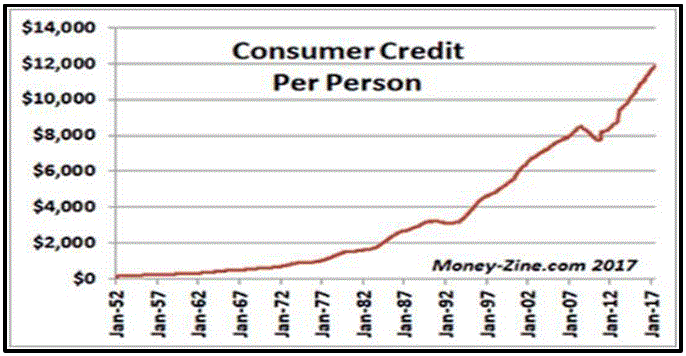
When you wonder why we don’t feel inflation will pick truly pick up, just look at this chart and remember that what the banks giveth, they can taketh away, and then how will one fund the payments? Can you say that is a huge deflationary wave that is just sitting out in the middle of the ocean waiting for the banks to pull the plug so it can come rushing in. Then again, we saw someone toss up a Velocity of Money chart and a potential bottom:
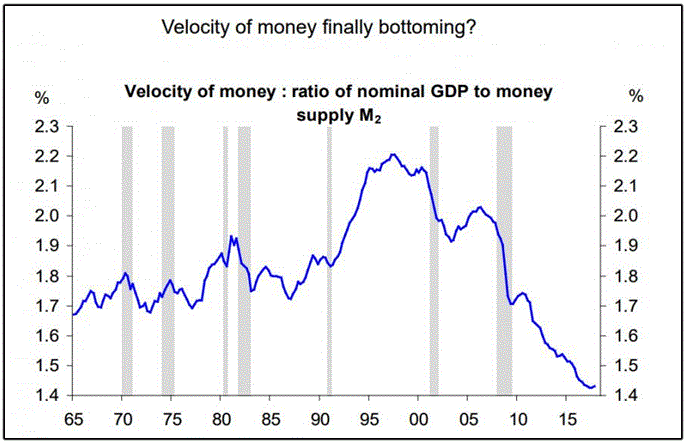
We might see it bottom in the short term, but too much debt is weighing this down and the good old MV=PQ will struggle because of that. Basically, if the “M” is falling, the “V” has to pick up or else inflation cannot rise, which it hasn’t and this old dog can’t be fooled. Sure, in the short run, yes, we can have bouts of it, but just look at Japan, that’s all we are saying. Debt is a long term independent constant, not a variable.
Ok enough of the fundamentals and fiscal outlook, let’s tighten the scope shall we. So, you long term investors out there need to realize that short term volatility can wreak real havoc on your return structures. In fact our good friend Nassim Taleb put out an excellent must view for readers on the misconception of risk and forecasting expectations. His tutorial can be viewed Here We often hear that long term investors can ignore short term market aberrations, well that is a crock of BS. Great traders and true value investors, know that it’s not only the return function that dictates long term success but WHERE AND WHEN YOU BEGIN TO BUY makes all the difference. Being the interest rate dictator that we are, we would like to present you this next chart. We don’t know where to give credit, but it’s a great example of the bond dog wagging the equity tail:
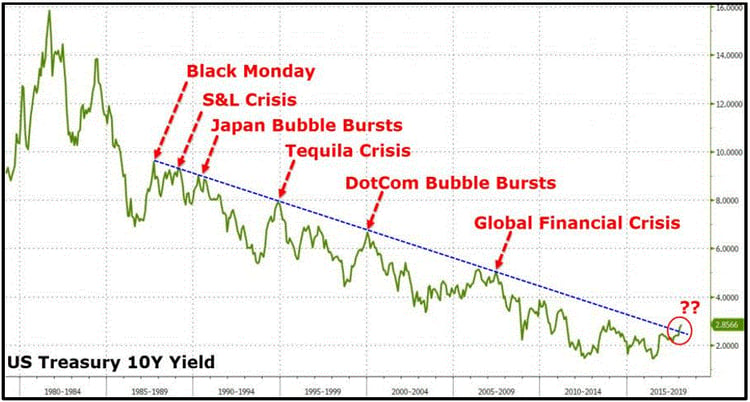
So, are you going to mess with 4 decades of consistency? Has the bond bear left the building? You have two choices, fight a trend that has been in place for nearly 4 decades and bet that nothing has changed or realize that in the short run, perhaps risk isn’t such a good thing at this point and that the bond markets are telling us something very important. Now we aren’t in the camp that rates can necessarily rise, but we aren’t naïve either. We had a conversation this week with an investor asking about the recent moves. In particular the question was about market timing and if its worth it to get out and get back in. We said think of it this way, not in regards to timing, but rather think in percentages. You are 100% invested and you have gone along for the QE ride this whole time, if the markets fall 25% you have to make 33.3% just to get back to where you were prior. Now we don’t know if the average investor realizes that in a rational market, 33.3% returns aren’t a given, nor should they be considered normal. So basically, we said, what’s your time worth vs speculating on further upside without central bank support? Will it hurt you to pull some chips off the table and move to a 30% cash defensive position? Certainly not, in fact we think it’s prudent depending upon ones given situation, now of course everyone’s risk tolerances and overall portfolios are different. We are merely talking common investing habits that make good economic sense to us.
What is our overall takeaway from all this recent action? We will continue to expect volatility to be high as the overall large player flows continue to volley for value. We expect that the recent sell off has given us a tradable new range and that there are both very large fundamental buyers as well as very large fundamental value sellers. We continue to expect corps to be large supporters and buy back equity, pensions and insurers to support on pullback for value and trend following, risk parity players to sell on rallies. All in all, this should make for some decent two-way flows. That’s the biggest take away we want our readers to understand is that financial markets ebb and flow-that is their true nature. We don’t expect a massive washout to occur all at once, in fact the central banks would never stand for it. They will and have back stopped the markets since the late 80s and probably longer in some way or another. This time is no different. Far too much is at stake and considering the entire world is financialized, the stakes are bigger and continue to get larger as the days go on. So, what are we seeing technically?
Thanks to Keystone charts for allowing us to share their great work, first up is the US Treasury 30Y where yield wise you can see 3.25% as the real magnet for now:
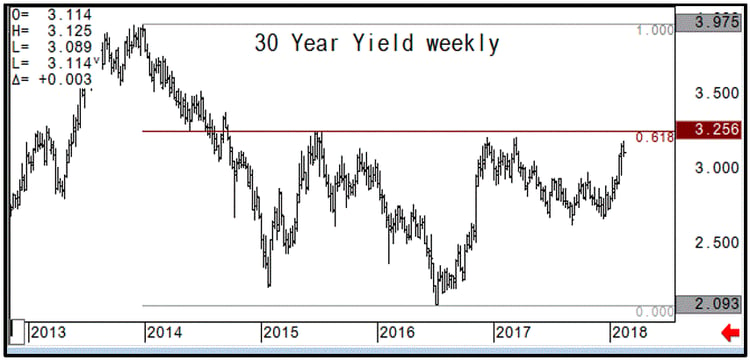
As far as the US 10Y 3% looms very large:
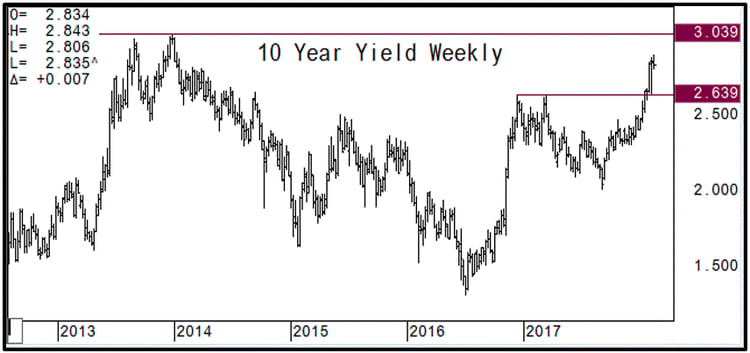
Heading over to equity land and the first chart here is the SP500 Future. As we discussed the new market range has been established and it is 2530 to 2725. We expect a large battle between these areas with funds playing both sides with sellers near the upper range and corresponding long-term player buyers near the 2530 area. Only a break of this range will change our sentiment:
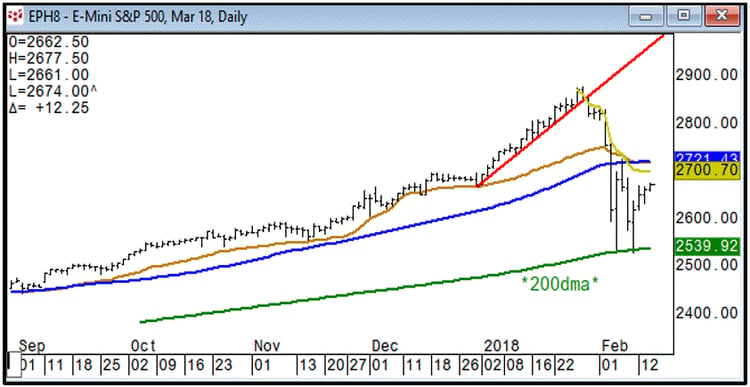
The NASDAQ Future lies between 6160 and 6705, but technically they both are trying to put in a short term bottom. It safe to expect selling near 6650:
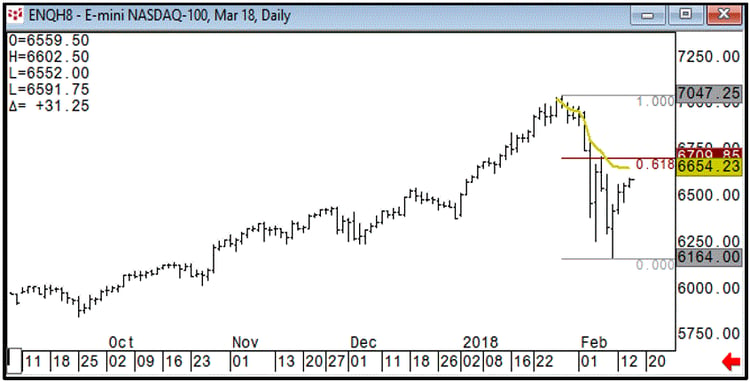
Crude Oil didn’t have a good week dropping nearly 10%! Technical damage has been done, but considering $58 was the breakout area, we should expect that to be first support, but the we aren’t sure if this is fundamental or mainly technically driven, perhaps the equity markets have had some residual effect on the complex:
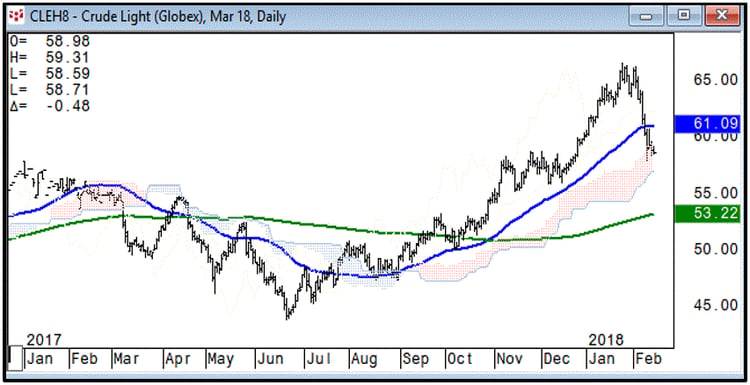
Our last chart is Gold, which is capped with a down trend line, it still seems to exhibit strength and 1307 area seems key for now, a break of this trendline to the upside will resume current bullish trend:
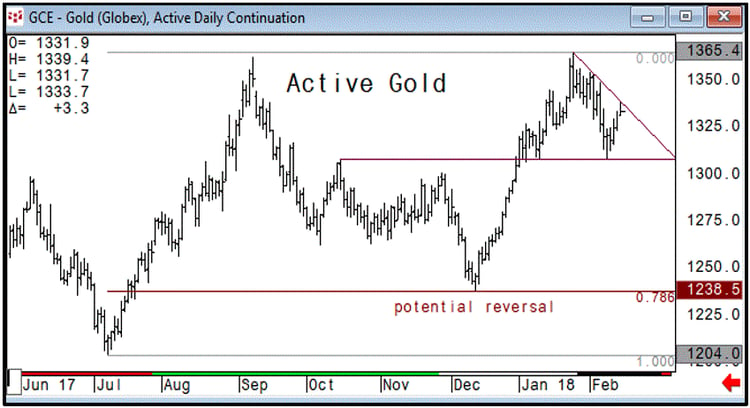
Finally, last week we saw SpaceX launch their “Falcon Heavy” rocket with a payload of, you guessed it a Tesla Roadster. What has become obvious to us is that, Elon Musk seems to be more of a publicity stuntman than anything else. A spokesman, salesman if you will, for who we aren’t quite sure yet. Anyway, we laughed when we heard him describe the whole thing, here is what he said, “It looks so ridiculous and impossible, you can tell it’s real because it looks so fake, honestly” Thanks Elon we understand your faith in the program than don’t we…can one say CGI??? Ok, that sounds conspiracy theory, but hey even Elon says it looks so fake!
Why do we comment on this, well because NASA, spends $52 million of public funds each and every day…SpaceX is more like an NGO, it is well connected with the US Airforce. We can comment on SpaceX and Tesla because from a monetary standpoint, it’s a gigantic black hole of public funds. We could think of countless more publicly beneficial programs that would benefit if they had $52 million a day to work with. Maybe Elon and Tesla/SpaceX don’t have to worry about losses, maybe we should just consider Elon Musk the Yuri Orlov from the movie Lord of War and you know how we love movies. If you don’t know what we mean…Yuri is a weapons dealer and gets arrested by Interpol and Interpol thinks they finally have their man, yet what Yuri says, and which is really a classic, A-typical true representation of power is displayed in the movie clip Here we won’t ruin it for you, but the agent has no idea who he is dealing with.
Ok that’s it, it’s a wrap, we leave you with the weekly settles. If some of you are wondering where the CryptoCorner is, we are now sending it separately as a letter of its own…anyway enjoy and if you would rather us continue putting into this newsletter, feel free to let us know. Cheers!
Finally, we will decidedly end our notes with our reaffirmation of the growing need for alternative strategies. We would like to think that our alternative view on markets is consistent with our preference for alternative risk and alpha driven strategies. Alternatives offer the investor a unique opportunity at non correlated returns and overall risk diversification. We believe combining traditional strategies with an alternative solution gives an investor a well-rounded approach to managing their long term portfolio. With the growing concentration of risk involved in passive index funds, with newly created artificial intelligence led investing and overall market illiquidity in times of market stress, alternatives can offset some of these risks.
It is our goal to keep you abreast of all the growing market risks as well as keep you aligned with potential alternative strategies to combat such risks. We hope you stay the course with us, ask more questions and become accustomed to looking at the markets from the same scope we do. Feel free to point out any inconsistencies, any questions that relate to the topics we talk about or even suggest certain markets that you may want more color upon.
___________________________________________________________________________________
Capital Trading Group, LLLP ("CTG") is an investment firm that believes safety and trust are the two most sought after attributes among investors and money managers alike. For over 30 years we have built our business and reputation in efforts to mitigate risk through diversification. We forge long-term relationships with both investors and money managers otherwise known as Commodity Trading Advisors (CTAs).
We are a firm with an important distinction: It is our belief that building strong relationships require more than offering a well-rounded set of investment vehicles; a first-hand understanding of the instruments and the organization behind those instruments is needed as well.
Futures trading is speculative and involves the potential loss of investment. Past results are not necessarily indicative of future results. Futures trading is not suitable for all investors.
Nell Sloane, Capital Trading Group, LLLP is not affiliated with nor do they endorse, sponsor, or recommend any product or service advertised herein, unless otherwise specifically noted.
This newsletter is published by Capital Trading Group, LLLP and Nell Sloane is the editor of this publication. The information contained herein was taken from financial information sources deemed to be reliable and accurate at the time it was published, but changes in the marketplace may cause this information to become out dated and obsolete. It should be noted that Capital Trading Group, LLLP nor Nell Sloane has verified the completeness of the information contained herein. Statements of opinion and recommendations, will be introduced as such, and generally reflect the judgment and opinions of Nell Sloane, these opinions may change at any time without written notice, and Capital Trading Group, LLLP assumes no duty or responsibility to update you regarding any changes. Market opinions contained herein are intended as general observations and are not intended as specific investment advice. Any references to products offered by Capital Trading Group, LLLP are not a solicitation for any investment. Readers are urged to contact your account representative for more information about the unique risks associated with futures trading and we encourage you to review all disclosures before making any decision to invest. This electronic newsletter does not constitute an offer of sales of any securities. Nell Sloane, Capital Trading Group, LLLP and their officers, directors, and/or employees may or may not have investments in markets or programs mentioned herein.
